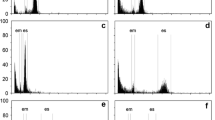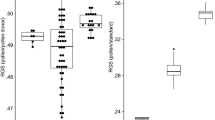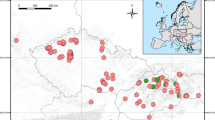Abstract
Key message
Our results indicate the existence of interploidy gene flow in Cystopteris fragilis, resulting in sexual triploid and diploid gametophytes from pentaploid parents. Similar evolutionary dynamics might operate in other fern complexes and need further investigation.
Abstract
Polyploidization and hybridization are a key evolutionary processes in ferns. Here, we outline an interploidy gene flow pathway operating in the polyploid Cystopteris fragilis complex. The conditions necessary for the existence of this pathway were tested. A total of 365 C. fragilis individuals were collected covering representatives of all three predominant ploidy levels (tetraploid, pentaploid, and hexaploid), cultivated, had their ploidy level estimated by flow cytometry, and their spores collected. The spores, as well as gametophytes and sporophytes established from them, were analysed by flow cytometry. Spore abortion rate was also estimated. In tetraploids, we observed the formation of unreduced (tetraploid) spores (ca 2%). Collected pentaploid individuals indicate ongoing hybridization between ploidy levels. Pentaploids formed up to 52% viable spores, ca 79% of them reduced, i.e. diploid and triploid. Reduced spores formed viable gametophytes, and, in the case of triploids, filial hexaploid sporophytes, showing evidence of sexual reproduction. Some tetraploid sporophytes reproduce apomictically (based on uniform ploidy of their metagenesis up to filial sporophytes). Triploid and diploid gametophytes from pentaploid parents are able to mate among themselves, or with “normal” reduced gametophytes from the sexual tetraploid sporophytes (the dominant ploidy level in the sporophytes in this populations), to produce tetraploid, pentaploid, and hexaploid sporophytes, allowing for geneflow from the pentaploids to both the tetraploid and hexaploid populations. Similar evolutionary dynamics might operate in other fern complexes and need further investigation.




Similar content being viewed by others
Data availability
Data are available in Supporting Information.
References
Barrington DS, Haufler CH, Werth CR (1989) Hybridization, reticulation, and species concepts in the ferns. Am Fern J 79:55–64. https://doi.org/10.2307/1547160
Bennett MD (1972) Nuclear DNA content and minimum generation time in herbaceous plants. Proc R Soc London Ser B Biol Sci 181:109–135. https://doi.org/10.1098/rspb.1972.0042
Chao Y-S, Liu H-Y, Chiang Y-C, Chiou W-L (2012) Polyploidy and speciation in Pteris (Pteridaceae). J Bot 2012:1–6. https://doi.org/10.1155/2012/817920
Clark J, Hidalgo O, Pellicer J et al (2016) Genome evolution of ferns: evidence for relative stasis of genome size across the fern phylogeny. New Phytol 210:1072–1082. https://doi.org/10.1111/nph.13833Key
Dodsworth S, Chase MW, Leitch AR (2016) Is post-polyploidization diploidization the key to the evolutionary success of angiosperms? Bot J Linn Soc 180:1–5. https://doi.org/10.1111/boj.12357
Doležal J, Krahulcová A, Urfus T, Krahulec F (2020) Residual sexuality of the apomict Pilosella rubra under natural conditions in the Krkonoše Mts. Preslia 92:403–428
Doležel J, Sgorbati S, Lucretti S (1992) Comparison of three DNA fluorochromes for flow cytometric estimation of nuclear DNA content in plants. Physiol Plant 85:625–631
Doležel J, Greilhuber J, Suda J (2007) Flow Cytometry with Plant Cells: Analysis of Genes. Chromosomes and Genomes. Wiley-VCH Verlag GmbH & Co, KGaA, Weinheim
Dyer AF, Parks JC, Lindsay S (2000) Historical review of the uncertain taxonomic status of Cystopteris dickieana R. Sim (Dickie’s bladder fern). Edinburgh J Bot 57:71–81
Ekrt L, Koutecký P (2016) Between sexual and apomictic: unexpectedly variable sporogenesis and production of viable polyhaploids in the pentaploid fern of the Dryopteris affinis agg. (Dryopteridaceae). Ann Bot 117:97–106. https://doi.org/10.1093/aob/mcv152
Ekrt L, Holubová R, Trávníček P, Suda J (2010) Species boundaries and frequency of hybridization in the Dryopteris carthusiana (Dryopteridaceae) complex: a taxonomic puzzle resolved using genome size data. Am J Bot 97:1208–1219. https://doi.org/10.3732/ajb.0900206
Ekrt L, Košnar J, Rothfels CJ, Hanušová K, Hornych O, Urfus T (2022) Cytogenetic, geographical, spore type and plastid haplotype data reveal cryptic patterns of species diversity in the cosmopolitan Cystopteris fragilis complex (Polypodiopsida: Cystopteridaceae). Bot J Linn Soc 199:728–739. https://doi.org/10.1093/botlinnean/boab078
Eschelmüller A (1998) Keimversuche mit Sporen der diploiden Sippen von Dryopteris affinis und ihren Bastarden mit Dryopteris filix-mas. Mitteilungen Des Naturwissenschaftlichen Arbeitskreises Kempten 35:27–50
Faizullah L, Morton JA, Hersch-Green EI et al (2021) Exploring environmental selection on genome size in angiosperms. Trends Plant Sci. https://doi.org/10.1016/j.tplants.2021.06.0011
Fowler NL, Levin DA (2016) Critical factors in the establishment of allopolyploids. Am J Bot 103:1236–1251. https://doi.org/10.3732/ajb.1500407
Gabancho LR, Prada C, y Galán JMG (2010) Sexuality and apogamy in the Cuban Asplenium auritum–monodon complex (Aspleniaceae). Plant Syst Evol 289:137–146. https://doi.org/10.1007/s00606-010-0339-5
Grusz AL (2016) A current perspective on apomixis in ferns. J Syst Evol 54:656–665. https://doi.org/10.1111/jse.12228
Grusz AL, Windham MD, Picard KT et al (2021) A drought-driven model for the evolution of obligate apomixis in ferns: evidence from pellaeids (Pteridaceae). Am J Bot 108:263–283. https://doi.org/10.1002/ajb2.1611
Guignard MS, Nichols RA, Knell RJ et al (2016) Genome size and ploidy influence angiosperm species’ biomass under nitrogen and phosphorus limitation. New Phytol 210:1195–1206. https://doi.org/10.1111/nph.13881
Guo Z-Y, Liu H-M (2013) Gametophyte morphology and development of three species of Cyrtogonellum Ching (Dryopteridaceae). Am Fern J 103:153–165. https://doi.org/10.1640/0002-8444-103.3.153
Hanušová K, Čertner M, Urfus T et al (2019) Widespread co-occurrence of multiple ploidy levels in fragile ferns (Cystopteris fragilis complex; Cystopteridaceae) probably stems from similar ecology of cytotypes, their efficient dispersal and inter-ploidy hybridization. Ann Bot 123:845–855. https://doi.org/10.1093/aob/mcy219
Haufler CH (2014) Ever since Klekowski: testing a set of radical hypotheses revives the genetics of ferns and lycophytes. Am J Bot 101:2036–2042. https://doi.org/10.1640/0002-8444-103.3.153
Haufler CH, Soltis DE (1986) Genetic evidence suggests that homosporous ferns with high chromosome numbers are diploid. Proc Natl Acad Sci 83:4389–4393
Haufler CH, Windham MD (1991) New species of North American Cystopteris and Polypodium, with comments on their reticulate relationships. Am Fern J 81:7–23
Haufler CH, Windham MD, Britton DM, Robinson SJ (1985) Triploidy and its evolutionary significance in Cystopteris protrusa. Can J Bot 63:1855–1863
Hegarty MJ, Hiscock SJ (2008) Genomic clues to the evolutionary success of polyploid plants. Curr Biol 18:R435–R444. https://doi.org/10.1016/j.cub.2008.03.043
Henry IM, Dilkes BP, Tyagi AP et al (2009) Dosage and parent-of-origin effects shaping aneuploid swarms in A. thaliana. Heredity (edinb) 103:458–468. https://doi.org/10.1038/hdy.2009.81
Henry TA, Bainard JD, Newmaster SG (2014) Genome size evolution in Ontario ferns (Polypodiidae): evolutionary correlations with cell size, spore size, and habitat type and an absence of genome downsizing. Genome 57:555–566. https://doi.org/10.1139/gen-2014-009
Hidalgo O, Pellicer J, Christenhusz M et al (2017a) Is there an upper limit to genome size? Trends Plant Sci 22:567–573. https://doi.org/10.1016/j.tplants.2017.04.005
Hidalgo O, Pellicer J, Christenhusz MJM et al (2017b) Genomic gigantism in the whisk-fern family (Psilotaceae): Tmesipteris obliqua challenges record holder Paris japonica. Bot J Linn Soc 183:509–514. https://doi.org/10.1093/botlinnean/box003
Hörandl E (2010) The evolution of self-fertility in apomictic plants. Sex Plant Reprod 23:73–86. https://doi.org/10.1007/s00497-009-0122-3
Hori K, Tono A, Fujimoto K et al (2014) Reticulate evolution in the apogamous Dryopteris varia complex (Dryopteridaceae, subg. Erythrovariae, sect. Variae) and its related sexual species in Japan. J Plant Res 127:661–684. https://doi.org/10.1007/s10265-014-0652-0
Hori K, Okuyama Y, Watano Y, Murakami N (2018a) Recurrent hybridization without homoeologous chromosome paring in the Dryopteris varia complex (Dryopteridaceae). Chromosom Bot 13:9–24. https://doi.org/10.3199/iscb.13.9
Hori K, Zhou X, Yan Y-H et al (2018b) Evidence for maternal ability in hybridization of apogamous fern species: Dryopteris tsushimense K. Hori & N. Murak. and D. subtsushimense K. Hori & N. Murak. (Dryopteridaceae), new tetraploid apogamous pteridophytes of hybrid origin from Tsushima. Japan Acta Phytotaxon Geobot 69:143–160. https://doi.org/10.18942/apg.201809
Hornych O, Ekrt L (2017) Spore abortion index (SAI) as a promising tool of evaluation of spore fitness in ferns: an insight into sexual and apomictic species. Plant Syst Evol 303:497–507. https://doi.org/10.1007/s00606-016-1386-3
Hornych O, Ekrt L, Riedel F et al (2019) Asymmetric hybridization in Central European populations of the Dryopteris carthusiana group. Am J Bot 106:1477–1486. https://doi.org/10.1002/ajb2.1369
Hornych O, Férová A, Hori K et al (2022) Apomictic fern fathers: an experimental approach to the reproductive characteristics of sexual, apomict, and hybrid fern gametophytes. Am J Bot 109:628–644. https://doi.org/10.1002/ajb2.1817
Huang Y-M, Hsu S-Y, Hsieh T-H et al (2011) Three Pteris species (Pteridaceae: Pteridophyta) reproduce by apogamy. Bot Stud 52:79–87
Husband BC (2000) Constraints on polyploid evolution: a test of the minority cytotype exclusion principle. Proc R Soc Lond B 267:217–223. https://doi.org/10.1098/rspb.2000.0990
Husband BC (2004) The role of triploid hybrids in the evolutionary dynamics of mixed-ploidy populations. Bot J Linn Soc 82:537–546. https://doi.org/10.1111/j.1095-8312.2004.00339.x
Jermy AC, Harper L (1971) Spore morphology of the Cystopteris fragilis complex. Br Fern Gaz 10:211–213
Jessen S, Lehmann L, Bujnoch W (2012) Cryptogramma bithynica spec. nov. (Pteridaceae, Pteridophyta)—a new fern species from Northwestern Anatolia/Turkey. Fern Gaz. 19:47
Kawakami SM, Kawakami S, Kato J et al (2010) Cytological study of a fern Cystopteris fragilis in Mongolian Altai. Chromosom Bot 5:1–3
Kawakami SM, Kawakami S, Damdinsuren O et al (2016) Decaploid gametophyte formation from spores of a pentaploid Cystopteris fragilis (Cystopteridaceae) collected in Mongolian Altai. Fern Gaz 20:149–155
Klekowski EJ Jr, Baker HG (1966) Evolutionary significance of polyploidy in the Pteridophyta. Science 153:305–307
Knight CA, Molinari NA, Petrov DA (2005) The large genome constraint hypothesis: evolution, ecology and phenotype. Ann Bot 95:177–190. https://doi.org/10.1093/aob/mci011
Kron P, Loureiro J, Castro S, Čertner M (2021) Flow cytometric analysis of pollen and spores: an overview of applications and methodology. Cytom Part A 99:348–358. https://doi.org/10.1002/cyto.a.24330
Kuo L, Huang Y, Chang J et al (2016) Evaluating the spore genome sizes of ferns and lycophytes: a flow cytometry approach. New Phytol. https://doi.org/10.1111/nph.14291
Leitch IJ, Bennett MD (2004) Genome downsizing in polyploid plants. Biol J Linn Soc 82:651–663
Li Z, McKibben MTW, Finch GS et al (2021) Patterns and processes of diploidization in land plants. Annu Rev Plant Biol 72:387–410. https://doi.org/10.1146/annurev-arplant-050718-100344
Lin S-J, Kato M, Iwatsuki K (1992) Diploid and triploid offspring of triploid agamosporous fern Dryopteris pacifica. J Plant Res 105:443–452
Liu H-M, Dyer RJ, Guo Z-Y et al (2012) The evolutionary dynamics of apomixis in ferns: a case study from polystichoid ferns. J Bot 2012:1–11. https://doi.org/10.1155/2012/510478
Liu H, Ekrt L, Koutecky P et al (2019) Polyploidy does not control all: Lineage-specific average chromosome length constrains genome size evolution in ferns. J Syst Evol 57:418–430. https://doi.org/10.1111/jse.12525
Mandákova T, Joly S, Krzywinski M et al (2010) Fast diploidization in close mesopolyploid relatives of Arabidopsis. Plant Cell 22:2277–2290. https://doi.org/10.1105/tpc.110.074526
Mandáková T, Li Z, Barker MS, Lysak MA (2017) Diverse genome organization following 13 independent mesopolyploid events in Brassicaceae contrasts with convergent patterns of gene retention. Plant J 91:3–21. https://doi.org/10.1111/tpj.13553
Manton I (1950) Problems of cytology and evolution in the Pteridophyta. Cambridge University Press, England
Matsumoto S (2003) Species ecological study on reproductive systems and speciation of Cyrtomium falcatum complex (Dryopteridaceae) in Japanese archipelago. Ann Tsukuba Bot Gard 22:141
Mayer MS, Mesler MR (1993) Morphometric evidence of hybrid swarms in mixed populations of Polystichum munitum and P. imbricans (Dryopteridaceae). Syst Bot 18:248–260
Nakato N, Masuyama S (2021) Polyploid progeny from triploid hybrids of Phegopteris decursivepinnata (Thelypteridaceae). J Plant Res 134:195–208. https://doi.org/10.1007/s10265-021-01255-x
Nakato N, Ootsuki R, Murakami N, Masuyama S (2012) Two types of partial fertility in a diploid population of the fern Thelypteris decursive-pinnata (Thelypteridaceae). J Plant Res 125:465–474. https://doi.org/10.1007/s10265-011-0461-7
Parks JC, Dyer AF, Lindsay S (2000) Allozyme, spore and frond variation in some Scottish populations of the ferns Cystopteris dickieana and Cystopteris fragilis. Edinburgh J Bot 57:83–105
Pelosi JA, Sessa EB (2021) From genomes to populations: a meta-analysis and review of fern population genetics. Int J Plant Sci 182:325–343. https://doi.org/10.1086/713442
Perrie LR, Shepherd LD, De Lange PJ, Brownsey PJ (2010) Parallel polyploid speciation: distinct sympatric gene-pools of recurrently derived allo-octoploid Asplenium ferns. Mol Ecol 19:2916–2932. https://doi.org/10.1111/j.1365-294X.2010.04705.x
Peskoller A, Silbernagl L, Hülber K et al (2021) Do pentaploid hybrids mediate gene flow between tetraploid Senecio disjunctus and hexaploid S. carniolicus s. str. (S. carniolicus aggregate, Asteraceae)? Alp Bot 131:151–160. https://doi.org/10.1007/s00035-021-00254-x
Picard KT, Ranft H, Grusz AL et al (2021) When it only takes one to tango: assessing the impact of apomixis in the fern genus Pteris. Am J Bot 108:2220–2234. https://doi.org/10.1002/ajb2.1761
Pinter I (1995) Progeny studies of the fern hybrid Polystichum x bicknellii (Dryopteridaceae: Pteridophyta). Fern Gaz 15:25–40
Regalado Gabancho L, Prada C, Gabriel y Galán JM (2010) Sexuality and apogamy in the Cuban Asplenium auritum-monodon complex (Aspleniaceae). Plant Syst Evol 289:137–146. https://doi.org/10.1007/s00606-010-0339-5
Rose JP, Dassler CL (2017) Spore production and dispersal in two temperate fern species, with an overview of the evolution of spore production in ferns. Am Fern J 107:136–155. https://doi.org/10.1640/0002-8444-107.3.136
Rothfels CJ, Windham MD, Pryer KM (2013) A plastid phylogeny of the cosmopolitan fern family cystopteridaceae (Polypodiopsida). Syst Bot 38:295–306. https://doi.org/10.1600/036364413X666787
Rothfels CJ, Johnson AK, Windham MD, Pryer KM (2014) Low-copy nuclear data confirm rampant allopolyploidy in the Cystopteridaceae (Polypodiales). Taxon 63:1026–1036. https://doi.org/10.12705/635.32
Rothfels CJ, Pryer KM, Li F (2017) Next-generation polyploid phylogenetics: rapid resolution of hybrid polyploid complexes using PacBio single-molecule sequencing. New Phytol 213:413–429. https://doi.org/10.1111/nph.14111
Schneider CA, Rasband WS, Eliceiri KW (2012) NIH Image to ImageJ: 25 years of image analysis. Nat Methods 9:671. https://doi.org/10.1038/nmeth.2089
Schneider H, Liu H, Chang Y et al (2017) Neo-and Paleopolyploidy contribute to the species diversity of Asplenium—the most species-rich genus of ferns. J Syst Evol 55:353–364. https://doi.org/10.1111/jse.12271
Schneller JJ (1975) Untersuchungen an einheimischen Farnen, insbesondere der Dryopteris filix max. 2. Teil, Cytologische Untersuchungen. Berichte Der Schweizerischen Bot Gessellschaft 85:1–17
Sessa EB, Zimmer EA, Givnish TJ (2012) Reticulate evolution on a global scale: a nuclear phylogeny for New World Dryopteris (Dryopteridaceae). Mol Phylogenet Evol 64:563–581. https://doi.org/10.1016/j.ympev.2012.05.009
Shimura Y (1964) Observations on the fertile fronds of Osmunda lancea var. latipinnula. J Jpn Bot 39:242–246
Sigel EM (2016) Genetic and genomic aspects of hybridization in ferns. J Syst Evol 54:638–655. https://doi.org/10.1111/jse.12226
Soltis DE, Soltis PS (1992) The distribution of selfing rates in homosporous ferns. Am J Bot 79:97–100
Soltis PS, Soltis DE (2016) Ancient WGD events as drivers of key innovations in angiosperms. Curr Opin Plant Biol 30:159–165. https://doi.org/10.1016/j.pbi.2016.03.015
Statsoft INC (2010) STATISTICA (data analysis software system), version 10
Tank DC, Eastman JM, Pennell MW et al (2015) Nested radiations and the pulse of angiosperm diversification: increased diversification rates often follow whole genome duplications. New Phytol 207:454–467. https://doi.org/10.1111/nph.13491
Testo WL, Watkins JE, Barrington DS (2015) Dynamics of asymmetrical hybridization in North American wood ferns: Reconciling patterns of inheritance with gametophyte reproductive biology. New Phytol 206:785–795. https://doi.org/10.1111/nph.13213
Van de Peer Y, Ashman T-L, Soltis PS, Soltis DE (2021) Polyploidy: an evolutionary and ecological force in stressful times. Plant Cell 33:11–26. https://doi.org/10.1093/plcell/koab149
Vida G (1974) Genome analysis of the European Cystopteris fragilis complex: 1. Tetraploid taxa. Acta Bot Acad Sci Hungaricae 20:181–192
Wagner WH, Wagner FS, Taylor WC (1986) Detecting abortive spores in herbarium specimens of sterile hybrids. Am Fern J 76:129–140
Walker TG (1962) Cytology and evolution in the fern genus Pteris L. Evolution 16:27–43
Walker TG (1985) Some aspects of agamospory in ferns—the Braithwaite system. Proc R Soc Edinburgh, Sect B Biol Sci 86:59–66
Wang J, Huo B, Liu W et al (2017) Abnormal meiosis in an intersectional allotriploid of Populus L. and segregation of ploidy levels in 2x× 3x progeny. PLoS ONE 12:e0181767. https://doi.org/10.1371/journal.pone.0181767
Wang X, Morton JA, Pellicer J et al (2021) Genome downsizing after polyploidy: mechanisms, rates and selection pressures. Plant J 107:1003–1015. https://doi.org/10.1111/tpj.15363
Widén CJ, Fraser-Jenkins C, Reichstein T, et al (1996) Phloroglucinol derivatives in Dryopteris sect. Fibrillosae and related taxa (Pteridophyta, Dryopteridaceae). In: Annales Botanici Fennici. JSTOR, pp 69–100
Wolf PG, Sessa EB, Marchant DB et al (2015) An exploration into fern genome space. Genome Biol Evol 7:2533–2544. https://doi.org/10.1093/gbe/evv163
Wood TE, Takebayashi N, Barker MS et al (2009) The frequency of polyploid speciation in vascular plants. Proc Natl Acad Sci 106:13875–13879. https://doi.org/10.1073/pnas.0811575106
Yatabe Y, Yamamoto K, Tsutsumi C et al (2011) Fertility and precocity of Osmunda× intermedia offspring in culture. J Plant Res 124:265–268. https://doi.org/10.1007/s10265-010-0374-x
Zenil-Ferguson R, Ponciano JM, Burleigh JG (2016) Evaluating the role of genome downsizing and size thresholds from genome size distributions in angiosperms. Am J Bot 103:1175–1186. https://doi.org/10.3732/ajb.1500408
Acknowledgements
We are grateful to Kristýna Hanušová for the first consultations about the evolutionary potential of Cystopteris fragilis and to Martin Čertner for his collaboration during field sampling.
Funding
This work was supported by the Grant Agency of Czech Republic (project no. 19-17379S).
Author information
Authors and Affiliations
Corresponding author
Ethics declarations
Conflict of interest
The authors declare no competing interest.
Additional information
Communicated by Claudia Köhler.
Publisher's Note
Springer Nature remains neutral with regard to jurisdictional claims in published maps and institutional affiliations.
Supplementary Information
Below is the link to the electronic supplementary material.
Rights and permissions
Springer Nature or its licensor (e.g. a society or other partner) holds exclusive rights to this article under a publishing agreement with the author(s) or other rightsholder(s); author self-archiving of the accepted manuscript version of this article is solely governed by the terms of such publishing agreement and applicable law.
About this article
Cite this article
Ptáček, J., Ekrt, L., Hornych, O. et al. Interploidy gene flow via a ‘pentaploid bridge’ and ploidy reduction in Cystopteris fragilis fern complex (Cystopteridaceae: Polypodiales). Plant Reprod 36, 321–331 (2023). https://doi.org/10.1007/s00497-023-00476-5
Received:
Accepted:
Published:
Issue Date:
DOI: https://doi.org/10.1007/s00497-023-00476-5




